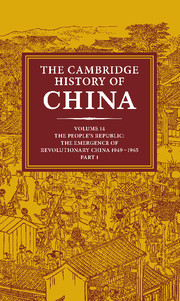Book contents
- Frontmatter
- 1 The reunification of China
- PART 1 EMULATING THE SOVIET MODEL, 1949–1957
- 2 Establishment and consolidation of the new regime
- 3 Economic recovery and the 1st Five-Year Plan
- 4 Education for the new order
- 5 The Party and the intellectuals
- 6 Foreign relations: from the Korean War to the Bandung Line
- PART II THE SEARCH FOR A CHINESE ROAD, 1958–1965
- Bibliographical Essays
- Bibliographical essays for chapters
- Bibliography
- Appendixes: Meetings and Leaders
- Conversion Tables: pinyin and Wade-Giles
- Glossary Index
- Map 1. China’s physical features
- Map 2. PRC: political (Wade–Giles romanization)
- Map 3. PRC: political (pinyin romanization)
- References
3 - Economic recovery and the 1st Five-Year Plan
from PART 1 - EMULATING THE SOVIET MODEL, 1949–1957
Published online by Cambridge University Press: 28 March 2008
- Frontmatter
- 1 The reunification of China
- PART 1 EMULATING THE SOVIET MODEL, 1949–1957
- 2 Establishment and consolidation of the new regime
- 3 Economic recovery and the 1st Five-Year Plan
- 4 Education for the new order
- 5 The Party and the intellectuals
- 6 Foreign relations: from the Korean War to the Bandung Line
- PART II THE SEARCH FOR A CHINESE ROAD, 1958–1965
- Bibliographical Essays
- Bibliographical essays for chapters
- Bibliography
- Appendixes: Meetings and Leaders
- Conversion Tables: pinyin and Wade-Giles
- Glossary Index
- Map 1. China’s physical features
- Map 2. PRC: political (Wade–Giles romanization)
- Map 3. PRC: political (pinyin romanization)
- References
Summary
When the Chinese Communist Party (CCP)wrested control of China from the Nationalist party (the KMT) in 1949, the economy was near collapse. Long-term structural problems characteristic of premodern economies, such as low per capita income, short life expectancy, low rates of savings and investment, and the predominance of traditional methods of production, were compounded by the loss of both physical and human capital and the hyperinflation that had accompanied more than two decades of international and civil war. But by the mid-1950s the short-term problems had been largely resolved and the Chinese Communist Party was completing a five-year development program that successfully addressed the most persistent structural problems as well. The rate of savings and investment had increased dramatically, life expectancy had already begun to rise in response to public health programs that curtailed infectious and parasitic diseases, and modern technology was being adopted on a large scale in industry.
This chapter explores the magnitude of the development problems faced by the Chinese at mid-century, analyzes the policies adopted, and assesses the record of accomplishment through the 1st Five-Year Plan (FYP) (1953–57). It seeks also to illuminate why the relatively successful strategy of the 1st FYP was abandoned almost immediately and replaced by the Great Leap Forward, a program of massive and unprecedented failure, the subject of Chapter 8 of this volume.
Keywords
- Type
- Chapter
- Information
- The Cambridge History of China , pp. 144 - 183Publisher: Cambridge University PressPrint publication year: 1987
References
- 9
- Cited by

